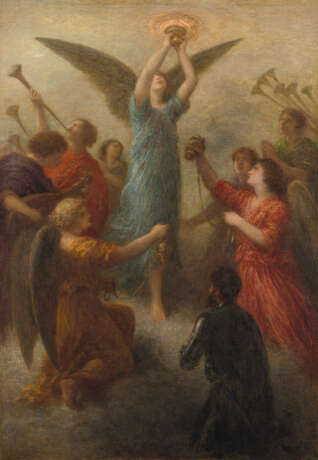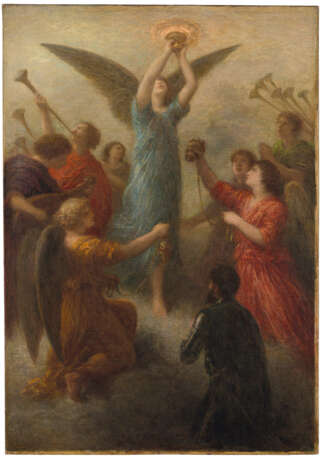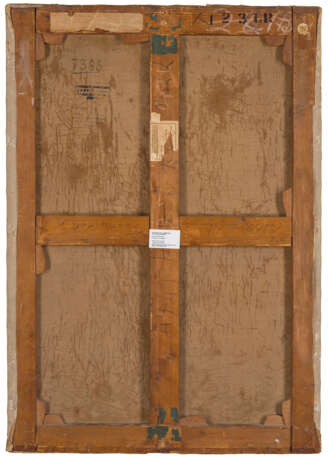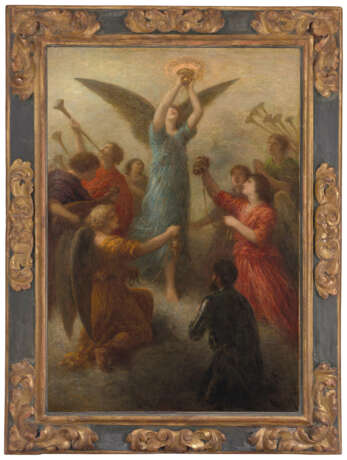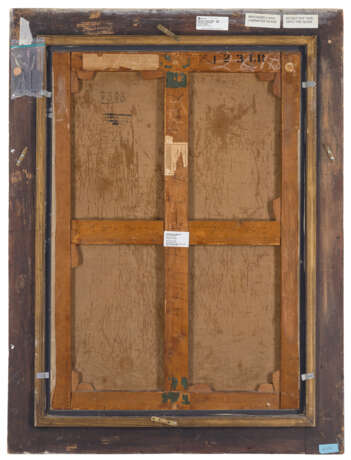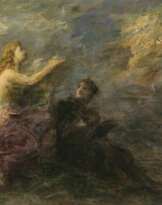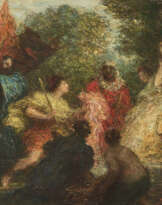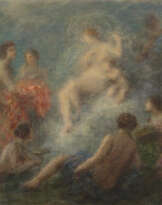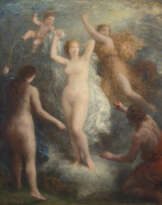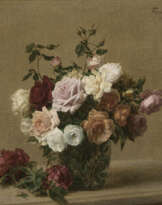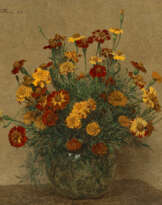ID 1178651
Los 168 | Henri Fantin-Latour (1836-1904)
Schätzwert
€ 70 000 – 100 000
Prélude de Lohengrin, Wagner
signé et daté 'Fantin. 92' (en bas à gauche)
huile sur toile
102.4 x 71.5 cm.
Peint en 1892
signed and dated 'Fantin. 92' (lower left)
oil on canvas
40 3⁄8 x 28 1⁄8 in.
Painted in 1892
Provenance
Charles Edward Haviland, Paris (avant 1906 et jusqu'à au moins 1911).
Galerie Durand-Ruel, Paris.
Georges Bernheim, Paris.
F. & J. Tempelaere, Paris.
Collection Lintillac, Vichy.
Albert Bellanger, Paris (en 1935).
Huinck & Scherjon N. V., Amsterdam (avant 1938).
Vente, Mensing & Fils (Frederik Muller & Cie), Amsterdam, 8 novembre 1955, lot 16.
Vente, Palais Galliera, Paris, 19 juin 1963, lot 19.
Sam Josefowitz, Pully (acquis au cours de cette vente).
Puis par descendance aux propriétaires actuels.
Literature
A. Proust, 'The Art of Fantin-Latour', in The Studio, An Illustrated Magazine of Fine and Applied Art, 1902, Vol. 24, p. 237 (illustré)
L. Bénédite et G. Hédiard, Fantin-Latour, Catalogue de lŒuvre lithographique du Maître, Paris, 1906, p. 50.
A. Jullien, Fantin-Latour, Sa vie et ses amitiés, Paris, 1909, p. 208.
Madame Fantin-Latour, Catalogue de l'œuvre complet de Fantin-Latour, Paris, 1911, p. 154, no. 1459.
M. E. Tralbaut, Richard Wagner im Blickwinkel fünf großer Maler, Hanri Fantin-Latour, Paul Cézanne, Odilon Redon, Auguste Renoir, Vincent van Gogh, Dortmund, 1965, p. 12.
H. C. Wolff, 'Ein Maker aks Lusikliebhaber, Fantin-Latour in Bayreuth', in Bayreuther Festspiele, Bayreuth, 1968, p. 2.
M. Verrier, Fantin-Latour, Paris, 1978, p. 80 (illustré).
Fantin-Latour, cat. exp., Galeries nationales du Grand Palais, Paris; Galerie nationale du Canada, Ottawa et California Palace of the Legion of Honour, San Francisco, 1982-1983, p. 291.
Exhibited
Paris, Exposition des Beaux-Arts, Salon de 1892, 1892, no. 656.
Paris, Palais de l'École Nationale des Beaux-Arts, Exposition de l'œuvre de Fantin-Latour, mai-juin 1906, p. 54, no. 153 (titré 'Le Graal (Prélude à Lohengrin)').
Amsterdam, Franck & Scherjon N. V., Peinture Hollandaise et Française, 1938, no. 25.
Montréal, Musée des Beaux-Arts, Paradis perdus, L'Europe symboliste, juin-octobre 1995, p. 511, no. 25 (illustré en couleurs, p. 47, fig. 25).
Munich, Bayerischen Nationalmuseums, Der Gral, Artusromantik in der Kunst des 19.Jahrhunderts, octobre 1995-janvier 1996, p. 200-202, no. 26 (illustré en couleurs, p. 201).
Darmstadt, Mathildenhöhe et Berlin, Bröhan-Museum, Art Nouveau, Symbolismus und Jugendstil in Frankreich, octobre 1999-juillet 2000, p. 47, no. 31 (illustré en couleurs).
Genève, Musée Rath, Richard Wagner, Visions d'Artistes, D'Auguste Renoir à Anselm Kiefer, septembre 2005-janvier 2006, p. 114, no. 17 (illustré en couleurs, p. 115).
Lausanne, Fondation de l'Hermitage, Fantin-Latour, De la réalité au rêve, juin-octobre 2007, p. 185, no. 73 (illustré en couleurs, p. 131).
Paris, Musée de la Musique, Richard Wagner, Visions d'artistes, D'Auguste Renoir à Anselm Kiefer, octobre 2007-janvier 2008.
Paris, Musée du Luxembourg et Grenoble, Musée de Grenoble, Fantin-Latour, À fleur de peau, septembre 2016-juin 2017, p. 222, no. 156 (illustré en couleurs, p. 223).
Further details
« J’ai commencé par copier les Maîtres, puis la vie. Depuis quelques années je peins mes songes. Je suis arrivé lentement de la réalité au rêve. Ce voyage a presque duré toute ma vie ».
Henri Fantin-Latour cité dans Fantin-Latour, À fleur de peau, cat. exp., Musée du Luxembourg, Paris et Musée de Grenoble, Grenoble, 2016-2017.
"I began by copying the Masters, then life itself. For some years now I've been painting my dreams. I have slowly moved from reality to dreams. This journey has lasted almost all my life.Henri Fantin-Latour quoted in Fantin-Latour, À fleur de peau, exh. cat., Musée du Luxembourg, Paris and Musée de Grenoble, Grenoble, 2016-2017.
Henri Fantin-Latour se fait tout d’abord un nom en peignant des portraits et des natures mortes, avant de se laisser aller à ce qu’il appelle ses « projets d’imagination ». L’imagination devient alors sa source d’inspiration, libérée par la musique et la féérie. Véritable mélomane, il représente les œuvres de Wagner, Schumann et Berlioz, dont les compositions lui permettent d’exprimer son âme de poète et son penchant pour l’onirique et le voluptueux. Il explore tout un monde, loin des contraintes commerciales.
Fou d’inspiration, Fantin-Latour réalise tout d’abord des lithographies, qu’il décline par la suite en couleurs en faisant des pastels et des huiles. De 1876 à 1899, il réalise alors 85 lithographies qu’il présente au Salon, faisant de ce nouveau sujet le thème de prédilection de la majorité de ses créations de l’époque.
Parmi ses compositeurs préférés, Wagner occupe une place particulière, même si à l’époque ce dernier souffre d’une impopularité aussi bien politique qu’artistique en France. Cela est notamment dû à sa farce anti-française publiée après le siège de Paris de 1870, Eine Kapitulation (1873). Fantin-Latour est alors le seul grand artiste de cette période à le soutenir ; ce dernier collabore d’ailleurs à La Revue Wagnérienne, lors de sa création en février 1885. Le peintre est particulièrement marqué par le chef d’œuvre romantique de Wagner, Lohengrin, et notamment par son prélude, souvent considéré comme le morceau le plus important de cet opéra.
Le choix d’un prélude, et non d’une ouverture classique, crée une continuité de la composition, lie la musique au texte : Fantin-Latour introduit alors des tonalités et motifs dont découleront toutes les situations au fil de l’histoire. Cela permet aussi d’immerger le spectateur dans une œuvre d’art total : Baudelaire se servira d’ailleurs de ce prélude pour illustrer sa théorie de correspondance entre les arts.
Dans cet opéra, Lohengrin, chevalier du Saint Graal, est envoyé sur son cygne sauver l’innocente Elsa de Brabant, accusée d’avoir tué son jeune frère. Dans le prélude, le Saint Graal descend du ciel pour lui donner des pouvoirs et ainsi l’aider dans sa quête.
Fantin-Latour représente ce prélude instrumental en suivant à la lettre le texte du programme de Wagner : on voit Lohengrin de dos au premier plan, tête nue, agenouillé et les mains jointes « quand enfin le Saint-Graal lui-même apparaît au milieu du cortège sacré, il s’abîme dans une adoration extatique, comme si le monde entier eut disparu » (C. Baudelaire, L'Art romantique, Paris, 1869, p. 212). Caractéristique de l’artiste, la lumière douce, vaporeuse, centralisée sur l’ange, invite le regard vers le haut, laissant le chevalier émerger doucement de l’ombre.
Les représentations d’opéra en gravure, pastels et huiles firent le succès de Fantin-Latour. L'artiste exposera d’ailleurs la présente œuvre au Salon de 1892, sous le numéro 656. Le fils de Wagner, Siegfried, écrira par la suite dans une lettre en 1903 « Je suppose que vous ne me demandez pas mon avis sur les illustrations des œuvres de mon père par M. Fantin-Latour, car depuis bon nombre d’années, elles occupent un rang parmi les compositions de ce genre les mieux appréciées et les plus renommées ».
Henri Fantin-Latour first made a name for himself painting portraits and still lifes, before indulging in what he called his "imaginative projects". Imagination became his source of inspiration, liberated by music and enchantment. A true music lover, he represented the works of Wagner, Schumann and Berlioz, whose compositions allowed him to express his poetic soul and his penchant for the dreamlike and voluptuous. He explored a whole world, far removed from commercial constraints. Fuelled by inspiration, Fantin-Latour began by producing lithographs, which he later turned into colour pastels and oils. Between 1876 and 1899, he produced 85 lithographs which he exhibited at the Salon, making this new subject the theme of choice for most of his work of the period.
Among his favourite composers, Wagner occupies a special place, even though at the time he was suffering from both political and artistic unpopularity in France. This was due in particular to his anti-French farce Eine Kapitulation (1873), published after the siege of Paris in 1870. Fantin-Latour was the only major artist of the period to support him; he also contributed to La Revue Wagnérienne, when it was founded in February 1885. The painter was particularly impressed by Wagner's romantic masterpiece, Lohengrin, and especially by its prelude, often considered the most important piece in the opera.
The choice of a prelude, rather than a classical overture, creates continuity in the composition and links the music to the text: Fantin-Latour introduces the tonalities and motifs from which all the situations in the story emerge. Baudelaire used this prelude to illustrate his theory of the correspondence between the arts.
In this opera, Lohengrin, knight of the Holy Grail, is sent on his swan to rescue the innocent Elsa of Brabant, accused of killing her younger brother. In the prelude, the Holy Grail descends from heaven to give him powers and thus help him in his quest.Fantin-Latour's depiction of this instrumental prelude follows the text of Wagner's programme to the letter: Lohengrin is shown with his back to the foreground, bareheaded, kneeling and with his hands clasped "when at last the Holy Grail itself appears in the midst of the sacred procession, he sinks into ecstatic adoration, as if the whole world had disappeared" (C. Baudelaire, L'Art romantique, Paris, 1869, p. 212). Characteristic of the artist, the soft, vaporous light, centred on the angel, invites the eye to look upwards, leaving the knight to emerge gently from the shadow. Fantin-Latour's success lay in his representations of opera in etchings, pastels and oils. The artist exhibited the present work at the Salon of 1892, under number 656. Wagner's son, Siegfried, later wrote in a letter in 1903: "I don't suppose you're asking my opinion of Mr Fantin-Latour's illustrations of my father's works, for for many years they have ranked among the best-appreciated and most renowned compositions of this kind.
| Künstler: | Henri Fantin-Latour (1836 - 1904) |
|---|---|
| Angewandte Technik: | Öl auf Leinwand |
| Kategorie des Auktionshauses: | Gemälde, Aquarelle, Zeichnungen, Gemälde |
| Künstler: | Henri Fantin-Latour (1836 - 1904) |
|---|---|
| Angewandte Technik: | Öl auf Leinwand |
| Kategorie des Auktionshauses: | Gemälde, Aquarelle, Zeichnungen, Gemälde |
| Adresse der Versteigerung |
CHRISTIE'S 9 Avenue Matignon 75008 Paris Frankreich | ||||||||||||||
|---|---|---|---|---|---|---|---|---|---|---|---|---|---|---|---|
| Vorschau |
| ||||||||||||||
| Telefon | +33 (0)1 40 76 85 85 | ||||||||||||||
| Fax | +33 (0)1 40 76 85 86 | ||||||||||||||
| Nutzungsbedingungen | Nutzungsbedingungen | ||||||||||||||
| Versand |
Postdienst Kurierdienst Selbstabholung | ||||||||||||||
| Zahlungsarten |
Banküberweisung | ||||||||||||||
| Geschäftszeiten | Geschäftszeiten
|
